Task 1a (i). The process of learning best takes place i
VerifiedAdded on 2022/10/02
|9
|2780
|1
AI Summary
Hi expert,
I've attached 8 files here, listed below:
1) 4 Pdf files of the set readings, must have a read and use these for reference.
2) EDF5016 task details (Please read it carefully, there are 3 parts for this assignment, total words of 1600 and two response)
3) Sample AT1; An assignment has been done by my classmate, she has submitted last week and got her result back, so please read her paper and give you some ideas what to do m please DO NOT COPY)
4) Assessment marking criteria ( please read the comments that our professor given to her, she did not get a high marks, so please read the comments, what were the weakness and strength of the assignment)
5) All the questions that you must read: PLEASE READ THIS FILE CAREFULLY AS these are the questions that you need to follow. so basically, in part A there are two questions, you need to respond 300 words each. Part B, 1000 WORDS of topic 4 collaborative learning, In part C, need to respond two of my peers post. as I have copied
Contribute Materials
Your contribution can guide someone’s learning journey. Share your
documents today.
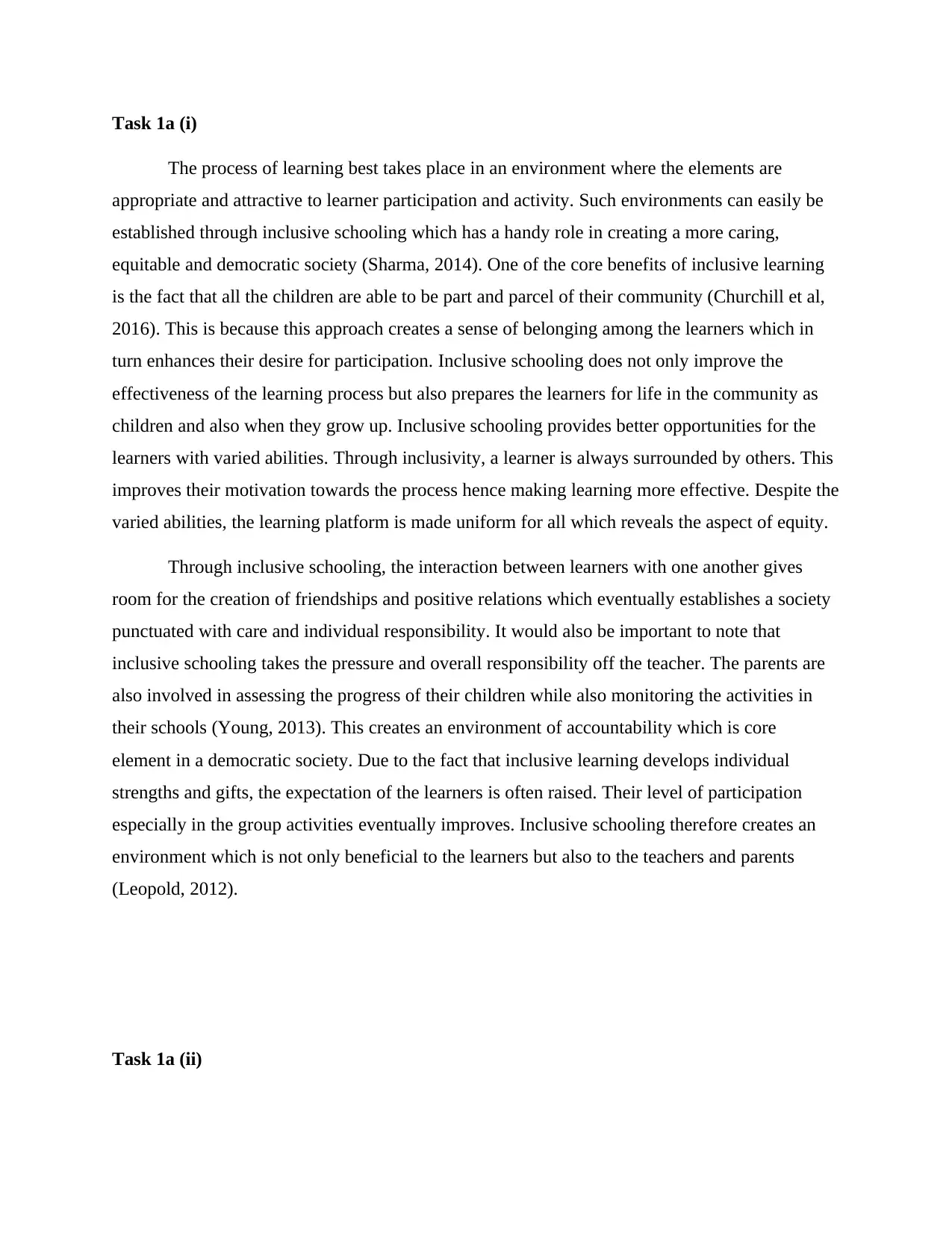
Task 1a (i)
The process of learning best takes place in an environment where the elements are
appropriate and attractive to learner participation and activity. Such environments can easily be
established through inclusive schooling which has a handy role in creating a more caring,
equitable and democratic society (Sharma, 2014). One of the core benefits of inclusive learning
is the fact that all the children are able to be part and parcel of their community (Churchill et al,
2016). This is because this approach creates a sense of belonging among the learners which in
turn enhances their desire for participation. Inclusive schooling does not only improve the
effectiveness of the learning process but also prepares the learners for life in the community as
children and also when they grow up. Inclusive schooling provides better opportunities for the
learners with varied abilities. Through inclusivity, a learner is always surrounded by others. This
improves their motivation towards the process hence making learning more effective. Despite the
varied abilities, the learning platform is made uniform for all which reveals the aspect of equity.
Through inclusive schooling, the interaction between learners with one another gives
room for the creation of friendships and positive relations which eventually establishes a society
punctuated with care and individual responsibility. It would also be important to note that
inclusive schooling takes the pressure and overall responsibility off the teacher. The parents are
also involved in assessing the progress of their children while also monitoring the activities in
their schools (Young, 2013). This creates an environment of accountability which is core
element in a democratic society. Due to the fact that inclusive learning develops individual
strengths and gifts, the expectation of the learners is often raised. Their level of participation
especially in the group activities eventually improves. Inclusive schooling therefore creates an
environment which is not only beneficial to the learners but also to the teachers and parents
(Leopold, 2012).
Task 1a (ii)
The process of learning best takes place in an environment where the elements are
appropriate and attractive to learner participation and activity. Such environments can easily be
established through inclusive schooling which has a handy role in creating a more caring,
equitable and democratic society (Sharma, 2014). One of the core benefits of inclusive learning
is the fact that all the children are able to be part and parcel of their community (Churchill et al,
2016). This is because this approach creates a sense of belonging among the learners which in
turn enhances their desire for participation. Inclusive schooling does not only improve the
effectiveness of the learning process but also prepares the learners for life in the community as
children and also when they grow up. Inclusive schooling provides better opportunities for the
learners with varied abilities. Through inclusivity, a learner is always surrounded by others. This
improves their motivation towards the process hence making learning more effective. Despite the
varied abilities, the learning platform is made uniform for all which reveals the aspect of equity.
Through inclusive schooling, the interaction between learners with one another gives
room for the creation of friendships and positive relations which eventually establishes a society
punctuated with care and individual responsibility. It would also be important to note that
inclusive schooling takes the pressure and overall responsibility off the teacher. The parents are
also involved in assessing the progress of their children while also monitoring the activities in
their schools (Young, 2013). This creates an environment of accountability which is core
element in a democratic society. Due to the fact that inclusive learning develops individual
strengths and gifts, the expectation of the learners is often raised. Their level of participation
especially in the group activities eventually improves. Inclusive schooling therefore creates an
environment which is not only beneficial to the learners but also to the teachers and parents
(Leopold, 2012).
Task 1a (ii)
Secure Best Marks with AI Grader
Need help grading? Try our AI Grader for instant feedback on your assignments.
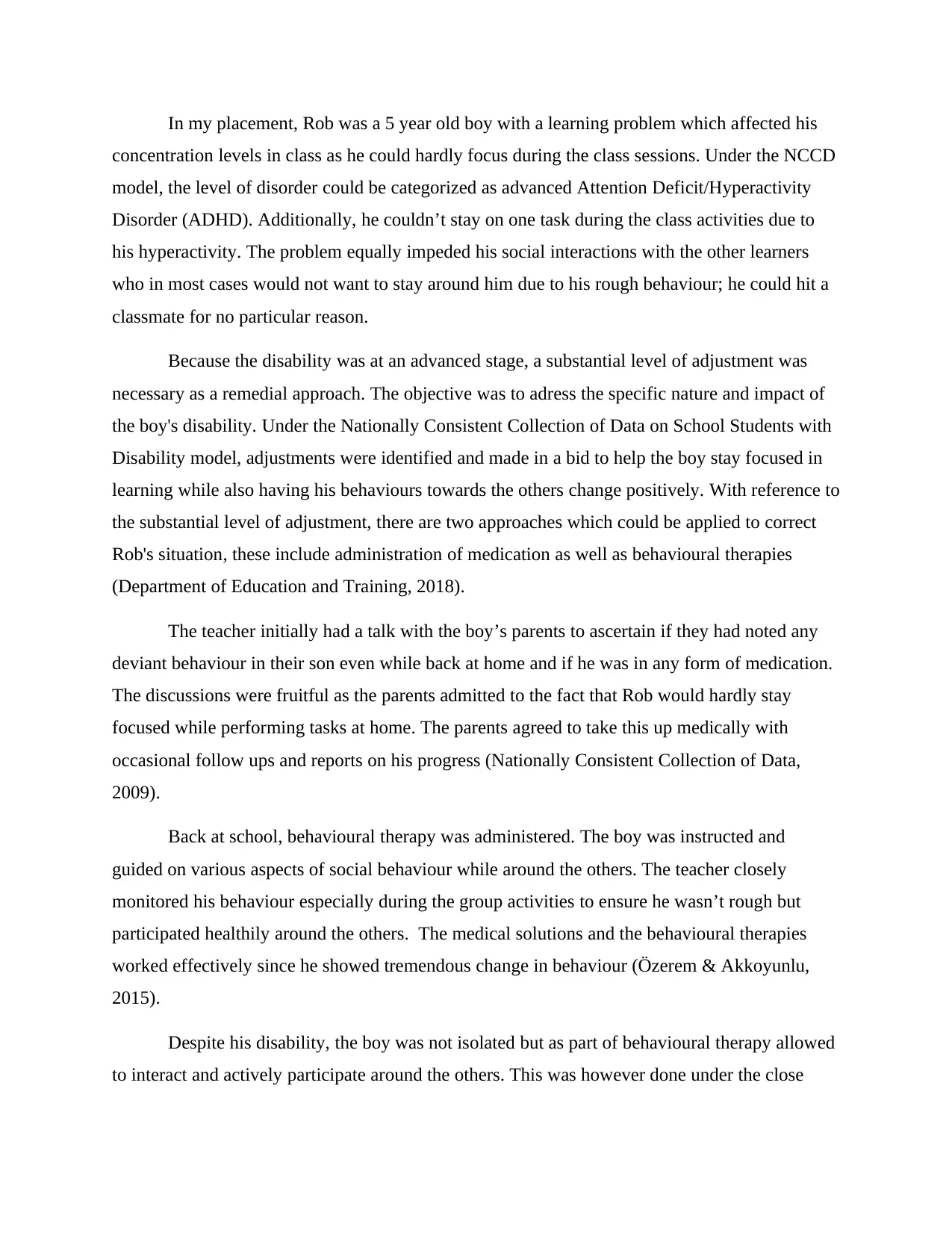
In my placement, Rob was a 5 year old boy with a learning problem which affected his
concentration levels in class as he could hardly focus during the class sessions. Under the NCCD
model, the level of disorder could be categorized as advanced Attention Deficit/Hyperactivity
Disorder (ADHD). Additionally, he couldn’t stay on one task during the class activities due to
his hyperactivity. The problem equally impeded his social interactions with the other learners
who in most cases would not want to stay around him due to his rough behaviour; he could hit a
classmate for no particular reason.
Because the disability was at an advanced stage, a substantial level of adjustment was
necessary as a remedial approach. The objective was to adress the specific nature and impact of
the boy's disability. Under the Nationally Consistent Collection of Data on School Students with
Disability model, adjustments were identified and made in a bid to help the boy stay focused in
learning while also having his behaviours towards the others change positively. With reference to
the substantial level of adjustment, there are two approaches which could be applied to correct
Rob's situation, these include administration of medication as well as behavioural therapies
(Department of Education and Training, 2018).
The teacher initially had a talk with the boy’s parents to ascertain if they had noted any
deviant behaviour in their son even while back at home and if he was in any form of medication.
The discussions were fruitful as the parents admitted to the fact that Rob would hardly stay
focused while performing tasks at home. The parents agreed to take this up medically with
occasional follow ups and reports on his progress (Nationally Consistent Collection of Data,
2009).
Back at school, behavioural therapy was administered. The boy was instructed and
guided on various aspects of social behaviour while around the others. The teacher closely
monitored his behaviour especially during the group activities to ensure he wasn’t rough but
participated healthily around the others. The medical solutions and the behavioural therapies
worked effectively since he showed tremendous change in behaviour (Özerem & Akkoyunlu,
2015).
Despite his disability, the boy was not isolated but as part of behavioural therapy allowed
to interact and actively participate around the others. This was however done under the close
concentration levels in class as he could hardly focus during the class sessions. Under the NCCD
model, the level of disorder could be categorized as advanced Attention Deficit/Hyperactivity
Disorder (ADHD). Additionally, he couldn’t stay on one task during the class activities due to
his hyperactivity. The problem equally impeded his social interactions with the other learners
who in most cases would not want to stay around him due to his rough behaviour; he could hit a
classmate for no particular reason.
Because the disability was at an advanced stage, a substantial level of adjustment was
necessary as a remedial approach. The objective was to adress the specific nature and impact of
the boy's disability. Under the Nationally Consistent Collection of Data on School Students with
Disability model, adjustments were identified and made in a bid to help the boy stay focused in
learning while also having his behaviours towards the others change positively. With reference to
the substantial level of adjustment, there are two approaches which could be applied to correct
Rob's situation, these include administration of medication as well as behavioural therapies
(Department of Education and Training, 2018).
The teacher initially had a talk with the boy’s parents to ascertain if they had noted any
deviant behaviour in their son even while back at home and if he was in any form of medication.
The discussions were fruitful as the parents admitted to the fact that Rob would hardly stay
focused while performing tasks at home. The parents agreed to take this up medically with
occasional follow ups and reports on his progress (Nationally Consistent Collection of Data,
2009).
Back at school, behavioural therapy was administered. The boy was instructed and
guided on various aspects of social behaviour while around the others. The teacher closely
monitored his behaviour especially during the group activities to ensure he wasn’t rough but
participated healthily around the others. The medical solutions and the behavioural therapies
worked effectively since he showed tremendous change in behaviour (Özerem & Akkoyunlu,
2015).
Despite his disability, the boy was not isolated but as part of behavioural therapy allowed
to interact and actively participate around the others. This was however done under the close
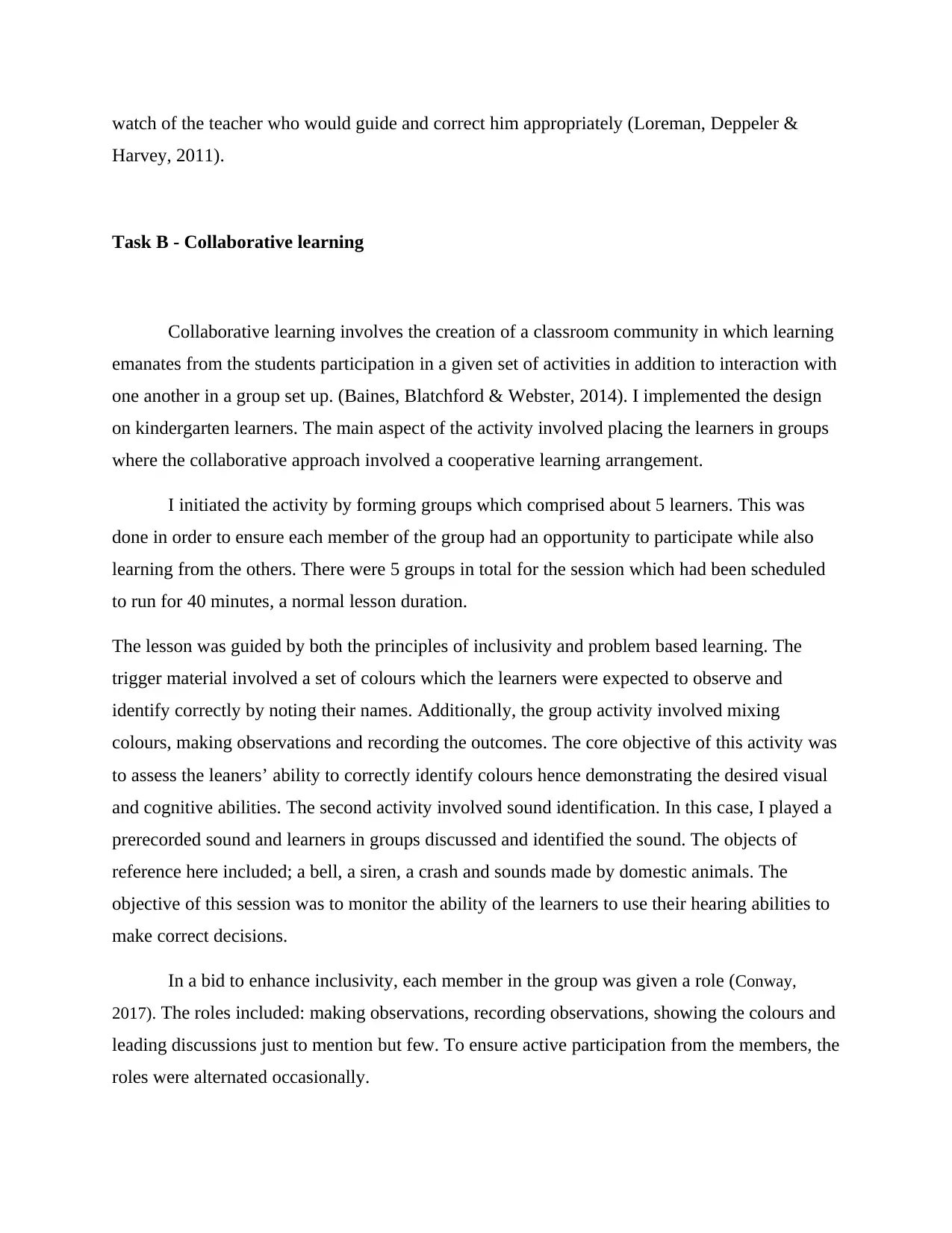
watch of the teacher who would guide and correct him appropriately (Loreman, Deppeler &
Harvey, 2011).
Task B - Collaborative learning
Collaborative learning involves the creation of a classroom community in which learning
emanates from the students participation in a given set of activities in addition to interaction with
one another in a group set up. (Baines, Blatchford & Webster, 2014). I implemented the design
on kindergarten learners. The main aspect of the activity involved placing the learners in groups
where the collaborative approach involved a cooperative learning arrangement.
I initiated the activity by forming groups which comprised about 5 learners. This was
done in order to ensure each member of the group had an opportunity to participate while also
learning from the others. There were 5 groups in total for the session which had been scheduled
to run for 40 minutes, a normal lesson duration.
The lesson was guided by both the principles of inclusivity and problem based learning. The
trigger material involved a set of colours which the learners were expected to observe and
identify correctly by noting their names. Additionally, the group activity involved mixing
colours, making observations and recording the outcomes. The core objective of this activity was
to assess the leaners’ ability to correctly identify colours hence demonstrating the desired visual
and cognitive abilities. The second activity involved sound identification. In this case, I played a
prerecorded sound and learners in groups discussed and identified the sound. The objects of
reference here included; a bell, a siren, a crash and sounds made by domestic animals. The
objective of this session was to monitor the ability of the learners to use their hearing abilities to
make correct decisions.
In a bid to enhance inclusivity, each member in the group was given a role (Conway,
2017). The roles included: making observations, recording observations, showing the colours and
leading discussions just to mention but few. To ensure active participation from the members, the
roles were alternated occasionally.
Harvey, 2011).
Task B - Collaborative learning
Collaborative learning involves the creation of a classroom community in which learning
emanates from the students participation in a given set of activities in addition to interaction with
one another in a group set up. (Baines, Blatchford & Webster, 2014). I implemented the design
on kindergarten learners. The main aspect of the activity involved placing the learners in groups
where the collaborative approach involved a cooperative learning arrangement.
I initiated the activity by forming groups which comprised about 5 learners. This was
done in order to ensure each member of the group had an opportunity to participate while also
learning from the others. There were 5 groups in total for the session which had been scheduled
to run for 40 minutes, a normal lesson duration.
The lesson was guided by both the principles of inclusivity and problem based learning. The
trigger material involved a set of colours which the learners were expected to observe and
identify correctly by noting their names. Additionally, the group activity involved mixing
colours, making observations and recording the outcomes. The core objective of this activity was
to assess the leaners’ ability to correctly identify colours hence demonstrating the desired visual
and cognitive abilities. The second activity involved sound identification. In this case, I played a
prerecorded sound and learners in groups discussed and identified the sound. The objects of
reference here included; a bell, a siren, a crash and sounds made by domestic animals. The
objective of this session was to monitor the ability of the learners to use their hearing abilities to
make correct decisions.
In a bid to enhance inclusivity, each member in the group was given a role (Conway,
2017). The roles included: making observations, recording observations, showing the colours and
leading discussions just to mention but few. To ensure active participation from the members, the
roles were alternated occasionally.
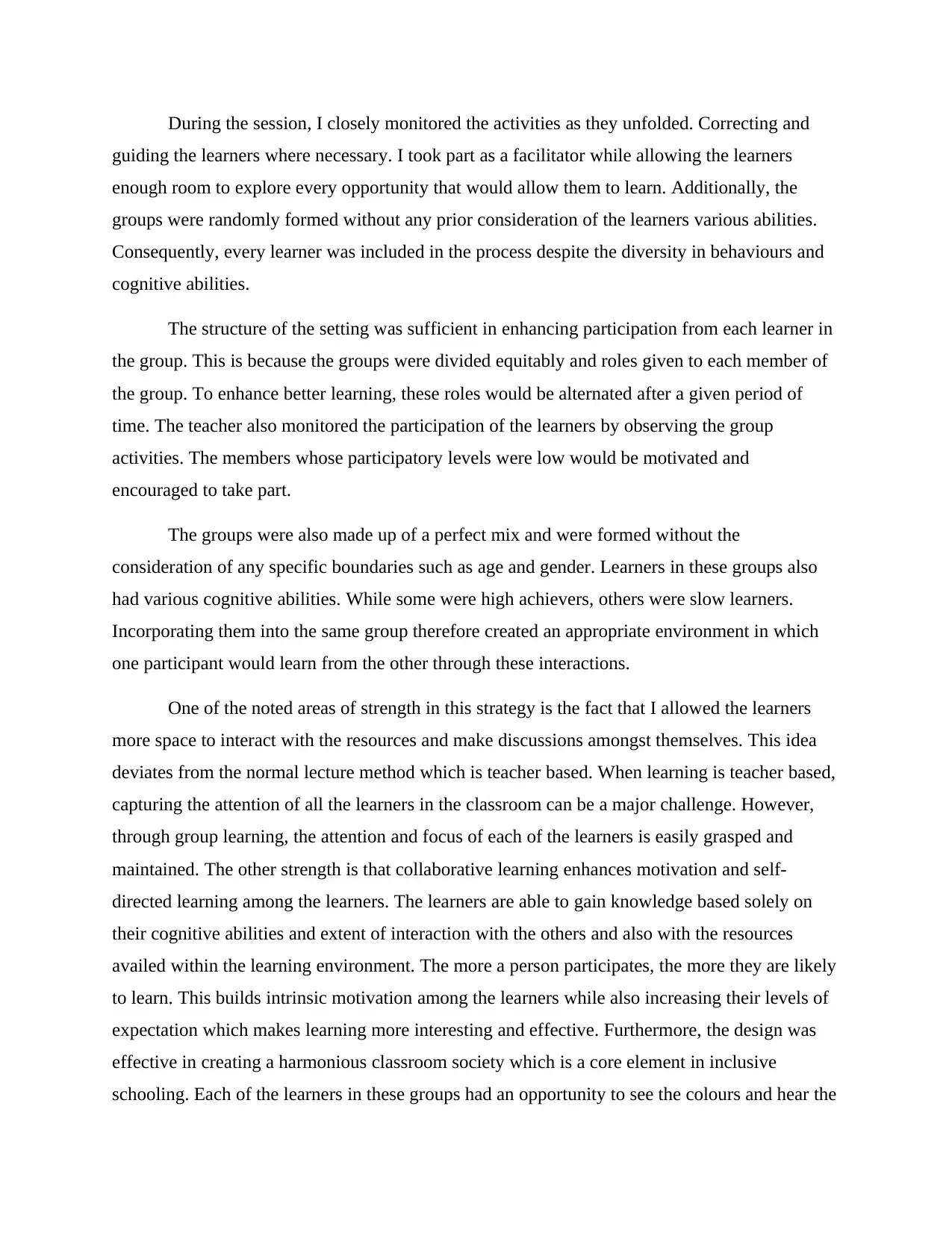
During the session, I closely monitored the activities as they unfolded. Correcting and
guiding the learners where necessary. I took part as a facilitator while allowing the learners
enough room to explore every opportunity that would allow them to learn. Additionally, the
groups were randomly formed without any prior consideration of the learners various abilities.
Consequently, every learner was included in the process despite the diversity in behaviours and
cognitive abilities.
The structure of the setting was sufficient in enhancing participation from each learner in
the group. This is because the groups were divided equitably and roles given to each member of
the group. To enhance better learning, these roles would be alternated after a given period of
time. The teacher also monitored the participation of the learners by observing the group
activities. The members whose participatory levels were low would be motivated and
encouraged to take part.
The groups were also made up of a perfect mix and were formed without the
consideration of any specific boundaries such as age and gender. Learners in these groups also
had various cognitive abilities. While some were high achievers, others were slow learners.
Incorporating them into the same group therefore created an appropriate environment in which
one participant would learn from the other through these interactions.
One of the noted areas of strength in this strategy is the fact that I allowed the learners
more space to interact with the resources and make discussions amongst themselves. This idea
deviates from the normal lecture method which is teacher based. When learning is teacher based,
capturing the attention of all the learners in the classroom can be a major challenge. However,
through group learning, the attention and focus of each of the learners is easily grasped and
maintained. The other strength is that collaborative learning enhances motivation and self-
directed learning among the learners. The learners are able to gain knowledge based solely on
their cognitive abilities and extent of interaction with the others and also with the resources
availed within the learning environment. The more a person participates, the more they are likely
to learn. This builds intrinsic motivation among the learners while also increasing their levels of
expectation which makes learning more interesting and effective. Furthermore, the design was
effective in creating a harmonious classroom society which is a core element in inclusive
schooling. Each of the learners in these groups had an opportunity to see the colours and hear the
guiding the learners where necessary. I took part as a facilitator while allowing the learners
enough room to explore every opportunity that would allow them to learn. Additionally, the
groups were randomly formed without any prior consideration of the learners various abilities.
Consequently, every learner was included in the process despite the diversity in behaviours and
cognitive abilities.
The structure of the setting was sufficient in enhancing participation from each learner in
the group. This is because the groups were divided equitably and roles given to each member of
the group. To enhance better learning, these roles would be alternated after a given period of
time. The teacher also monitored the participation of the learners by observing the group
activities. The members whose participatory levels were low would be motivated and
encouraged to take part.
The groups were also made up of a perfect mix and were formed without the
consideration of any specific boundaries such as age and gender. Learners in these groups also
had various cognitive abilities. While some were high achievers, others were slow learners.
Incorporating them into the same group therefore created an appropriate environment in which
one participant would learn from the other through these interactions.
One of the noted areas of strength in this strategy is the fact that I allowed the learners
more space to interact with the resources and make discussions amongst themselves. This idea
deviates from the normal lecture method which is teacher based. When learning is teacher based,
capturing the attention of all the learners in the classroom can be a major challenge. However,
through group learning, the attention and focus of each of the learners is easily grasped and
maintained. The other strength is that collaborative learning enhances motivation and self-
directed learning among the learners. The learners are able to gain knowledge based solely on
their cognitive abilities and extent of interaction with the others and also with the resources
availed within the learning environment. The more a person participates, the more they are likely
to learn. This builds intrinsic motivation among the learners while also increasing their levels of
expectation which makes learning more interesting and effective. Furthermore, the design was
effective in creating a harmonious classroom society which is a core element in inclusive
schooling. Each of the learners in these groups had an opportunity to see the colours and hear the
Secure Best Marks with AI Grader
Need help grading? Try our AI Grader for instant feedback on your assignments.
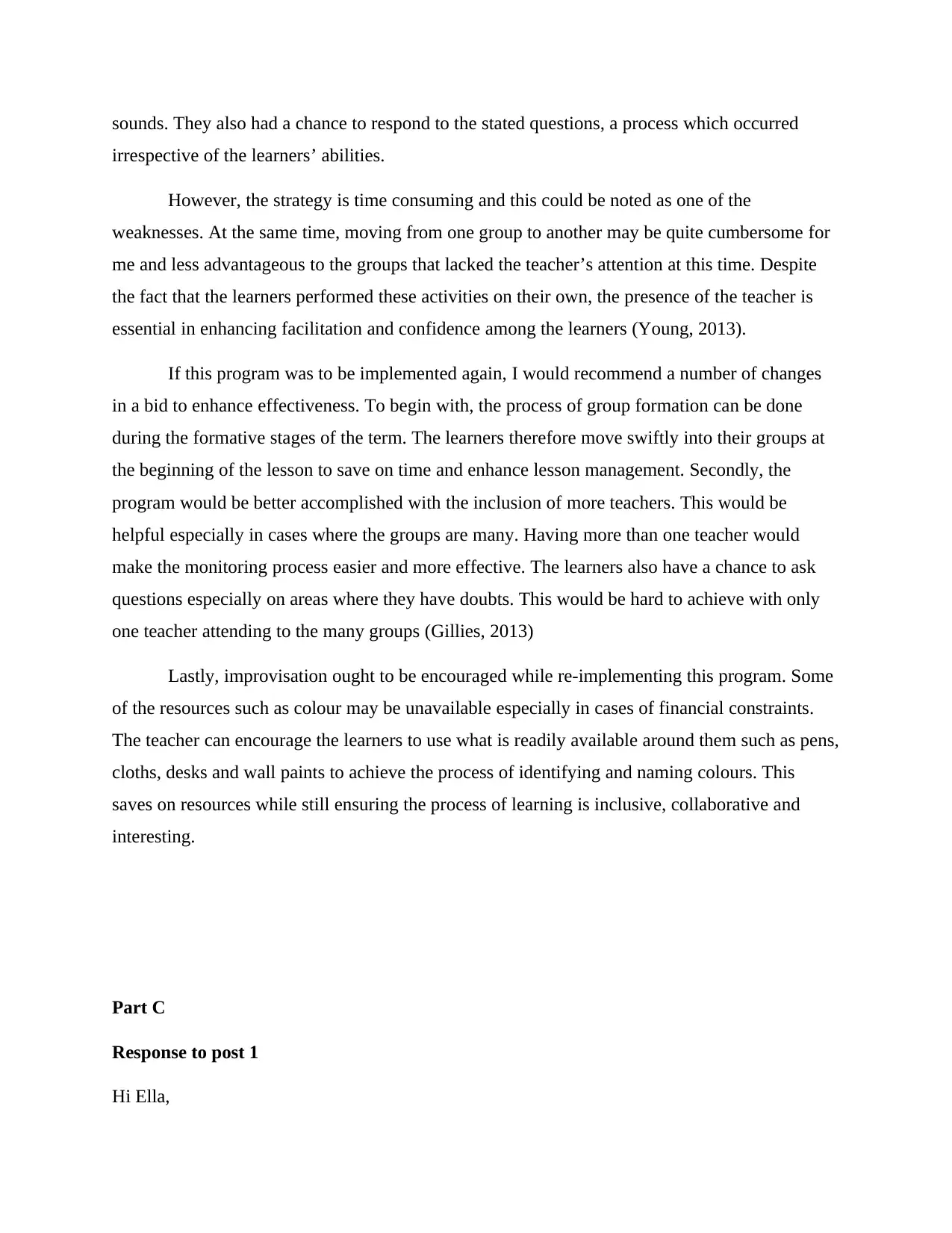
sounds. They also had a chance to respond to the stated questions, a process which occurred
irrespective of the learners’ abilities.
However, the strategy is time consuming and this could be noted as one of the
weaknesses. At the same time, moving from one group to another may be quite cumbersome for
me and less advantageous to the groups that lacked the teacher’s attention at this time. Despite
the fact that the learners performed these activities on their own, the presence of the teacher is
essential in enhancing facilitation and confidence among the learners (Young, 2013).
If this program was to be implemented again, I would recommend a number of changes
in a bid to enhance effectiveness. To begin with, the process of group formation can be done
during the formative stages of the term. The learners therefore move swiftly into their groups at
the beginning of the lesson to save on time and enhance lesson management. Secondly, the
program would be better accomplished with the inclusion of more teachers. This would be
helpful especially in cases where the groups are many. Having more than one teacher would
make the monitoring process easier and more effective. The learners also have a chance to ask
questions especially on areas where they have doubts. This would be hard to achieve with only
one teacher attending to the many groups (Gillies, 2013)
Lastly, improvisation ought to be encouraged while re-implementing this program. Some
of the resources such as colour may be unavailable especially in cases of financial constraints.
The teacher can encourage the learners to use what is readily available around them such as pens,
cloths, desks and wall paints to achieve the process of identifying and naming colours. This
saves on resources while still ensuring the process of learning is inclusive, collaborative and
interesting.
Part C
Response to post 1
Hi Ella,
irrespective of the learners’ abilities.
However, the strategy is time consuming and this could be noted as one of the
weaknesses. At the same time, moving from one group to another may be quite cumbersome for
me and less advantageous to the groups that lacked the teacher’s attention at this time. Despite
the fact that the learners performed these activities on their own, the presence of the teacher is
essential in enhancing facilitation and confidence among the learners (Young, 2013).
If this program was to be implemented again, I would recommend a number of changes
in a bid to enhance effectiveness. To begin with, the process of group formation can be done
during the formative stages of the term. The learners therefore move swiftly into their groups at
the beginning of the lesson to save on time and enhance lesson management. Secondly, the
program would be better accomplished with the inclusion of more teachers. This would be
helpful especially in cases where the groups are many. Having more than one teacher would
make the monitoring process easier and more effective. The learners also have a chance to ask
questions especially on areas where they have doubts. This would be hard to achieve with only
one teacher attending to the many groups (Gillies, 2013)
Lastly, improvisation ought to be encouraged while re-implementing this program. Some
of the resources such as colour may be unavailable especially in cases of financial constraints.
The teacher can encourage the learners to use what is readily available around them such as pens,
cloths, desks and wall paints to achieve the process of identifying and naming colours. This
saves on resources while still ensuring the process of learning is inclusive, collaborative and
interesting.
Part C
Response to post 1
Hi Ella,
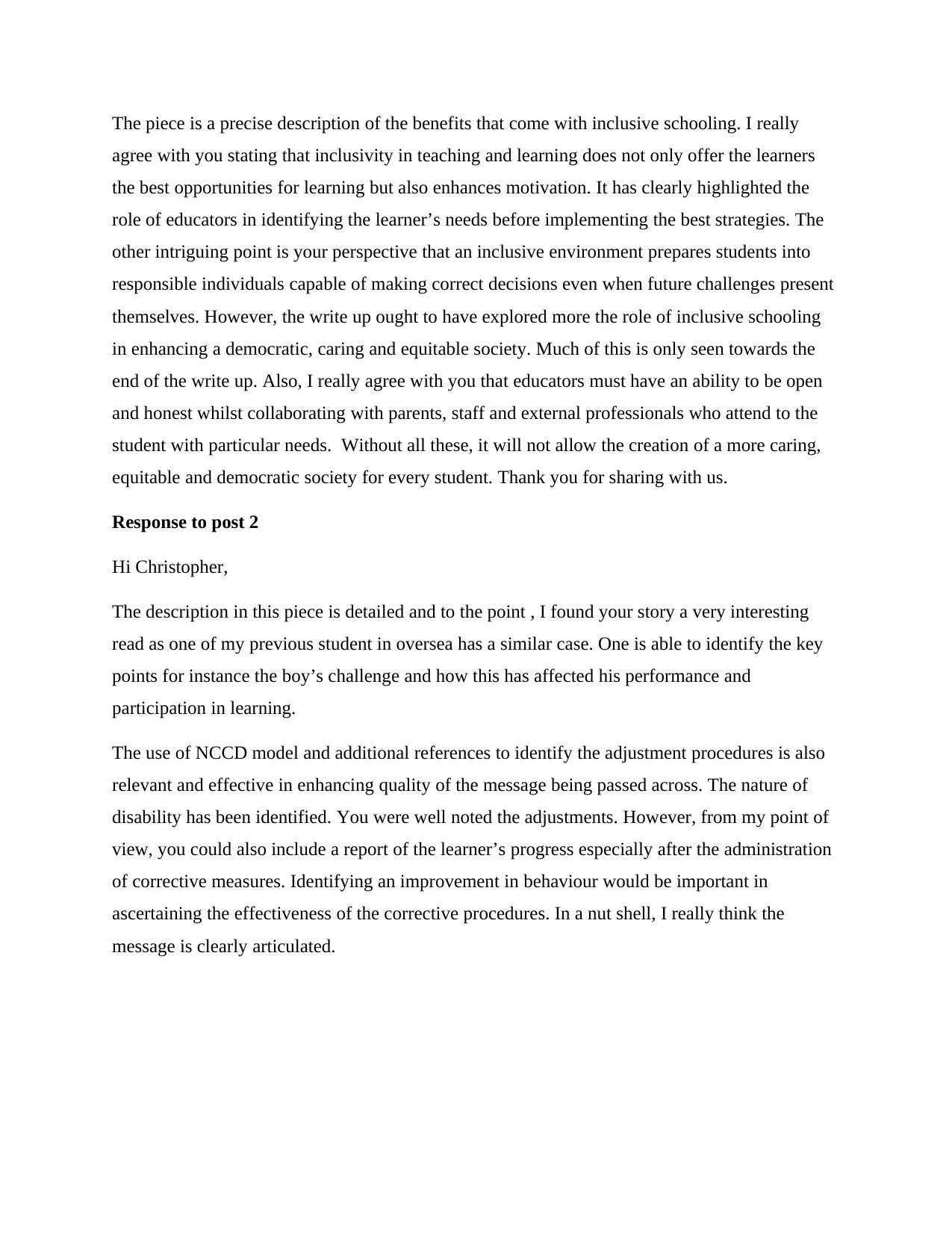
The piece is a precise description of the benefits that come with inclusive schooling. I really
agree with you stating that inclusivity in teaching and learning does not only offer the learners
the best opportunities for learning but also enhances motivation. It has clearly highlighted the
role of educators in identifying the learner’s needs before implementing the best strategies. The
other intriguing point is your perspective that an inclusive environment prepares students into
responsible individuals capable of making correct decisions even when future challenges present
themselves. However, the write up ought to have explored more the role of inclusive schooling
in enhancing a democratic, caring and equitable society. Much of this is only seen towards the
end of the write up. Also, I really agree with you that educators must have an ability to be open
and honest whilst collaborating with parents, staff and external professionals who attend to the
student with particular needs. Without all these, it will not allow the creation of a more caring,
equitable and democratic society for every student. Thank you for sharing with us.
Response to post 2
Hi Christopher,
The description in this piece is detailed and to the point , I found your story a very interesting
read as one of my previous student in oversea has a similar case. One is able to identify the key
points for instance the boy’s challenge and how this has affected his performance and
participation in learning.
The use of NCCD model and additional references to identify the adjustment procedures is also
relevant and effective in enhancing quality of the message being passed across. The nature of
disability has been identified. You were well noted the adjustments. However, from my point of
view, you could also include a report of the learner’s progress especially after the administration
of corrective measures. Identifying an improvement in behaviour would be important in
ascertaining the effectiveness of the corrective procedures. In a nut shell, I really think the
message is clearly articulated.
agree with you stating that inclusivity in teaching and learning does not only offer the learners
the best opportunities for learning but also enhances motivation. It has clearly highlighted the
role of educators in identifying the learner’s needs before implementing the best strategies. The
other intriguing point is your perspective that an inclusive environment prepares students into
responsible individuals capable of making correct decisions even when future challenges present
themselves. However, the write up ought to have explored more the role of inclusive schooling
in enhancing a democratic, caring and equitable society. Much of this is only seen towards the
end of the write up. Also, I really agree with you that educators must have an ability to be open
and honest whilst collaborating with parents, staff and external professionals who attend to the
student with particular needs. Without all these, it will not allow the creation of a more caring,
equitable and democratic society for every student. Thank you for sharing with us.
Response to post 2
Hi Christopher,
The description in this piece is detailed and to the point , I found your story a very interesting
read as one of my previous student in oversea has a similar case. One is able to identify the key
points for instance the boy’s challenge and how this has affected his performance and
participation in learning.
The use of NCCD model and additional references to identify the adjustment procedures is also
relevant and effective in enhancing quality of the message being passed across. The nature of
disability has been identified. You were well noted the adjustments. However, from my point of
view, you could also include a report of the learner’s progress especially after the administration
of corrective measures. Identifying an improvement in behaviour would be important in
ascertaining the effectiveness of the corrective procedures. In a nut shell, I really think the
message is clearly articulated.
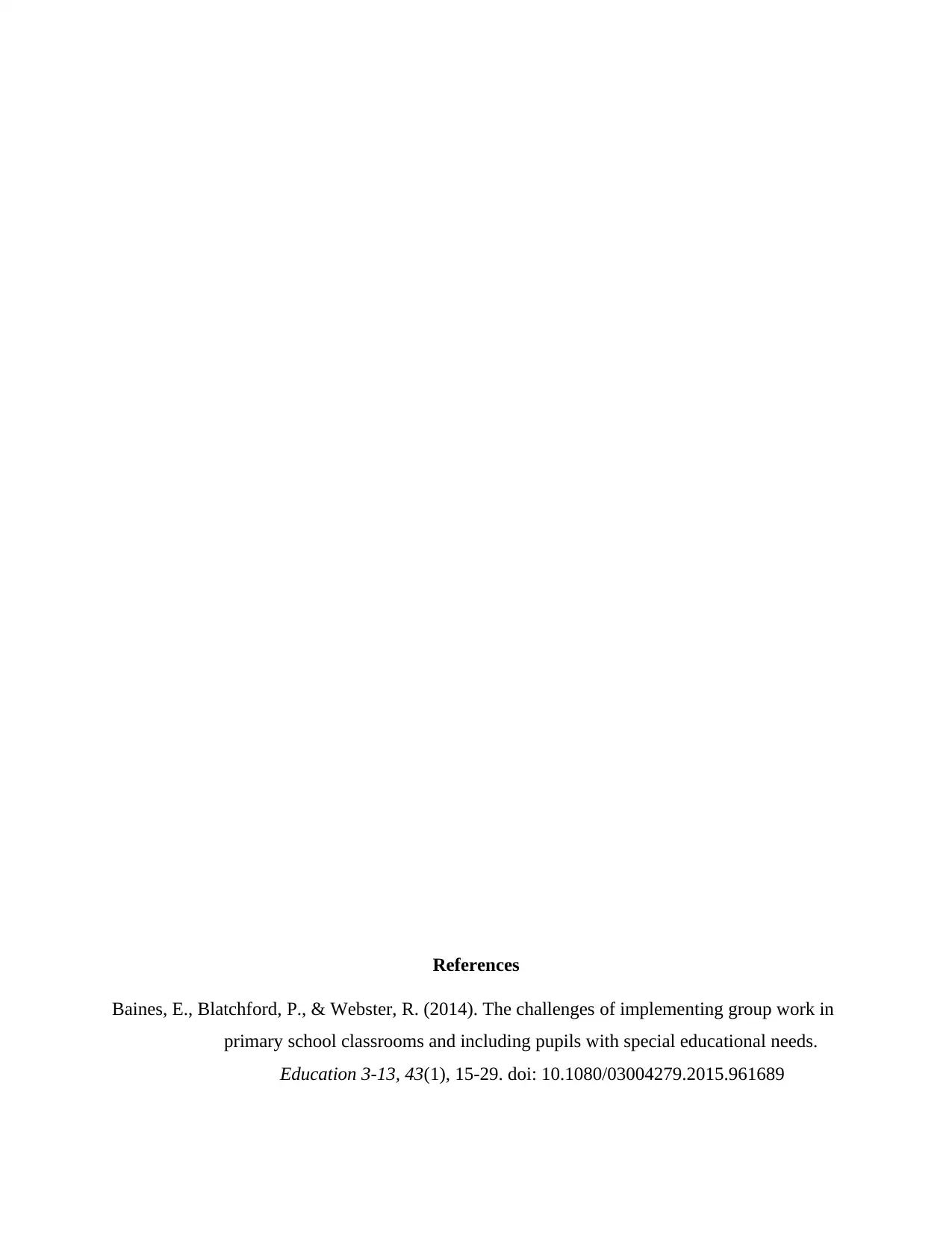
References
Baines, E., Blatchford, P., & Webster, R. (2014). The challenges of implementing group work in
primary school classrooms and including pupils with special educational needs.
Education 3-13, 43(1), 15-29. doi: 10.1080/03004279.2015.961689
Baines, E., Blatchford, P., & Webster, R. (2014). The challenges of implementing group work in
primary school classrooms and including pupils with special educational needs.
Education 3-13, 43(1), 15-29. doi: 10.1080/03004279.2015.961689
Paraphrase This Document
Need a fresh take? Get an instant paraphrase of this document with our AI Paraphraser
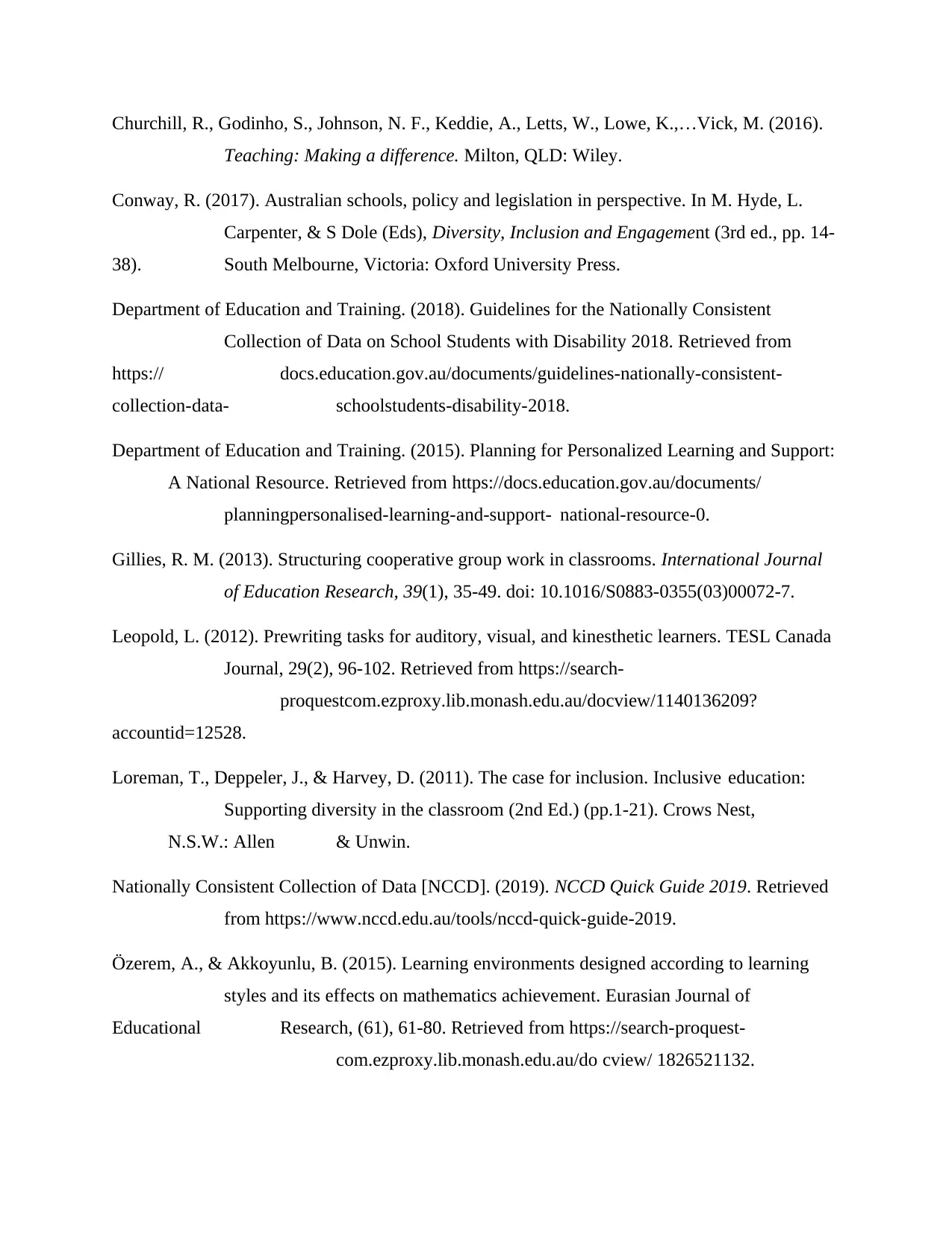
Churchill, R., Godinho, S., Johnson, N. F., Keddie, A., Letts, W., Lowe, K.,…Vick, M. (2016).
Teaching: Making a difference. Milton, QLD: Wiley.
Conway, R. (2017). Australian schools, policy and legislation in perspective. In M. Hyde, L.
Carpenter, & S Dole (Eds), Diversity, Inclusion and Engagement (3rd ed., pp. 14-
38). South Melbourne, Victoria: Oxford University Press.
Department of Education and Training. (2018). Guidelines for the Nationally Consistent
Collection of Data on School Students with Disability 2018. Retrieved from
https:// docs.education.gov.au/documents/guidelines-nationally-consistent-
collection-data- schoolstudents-disability-2018.
Department of Education and Training. (2015). Planning for Personalized Learning and Support:
A National Resource. Retrieved from https://docs.education.gov.au/documents/
planningpersonalised-learning-and-support- national-resource-0.
Gillies, R. M. (2013). Structuring cooperative group work in classrooms. International Journal
of Education Research, 39(1), 35-49. doi: 10.1016/S0883-0355(03)00072-7.
Leopold, L. (2012). Prewriting tasks for auditory, visual, and kinesthetic learners. TESL Canada
Journal, 29(2), 96-102. Retrieved from https://search-
proquestcom.ezproxy.lib.monash.edu.au/docview/1140136209?
accountid=12528.
Loreman, T., Deppeler, J., & Harvey, D. (2011). The case for inclusion. Inclusive education:
Supporting diversity in the classroom (2nd Ed.) (pp.1-21). Crows Nest,
N.S.W.: Allen & Unwin.
Nationally Consistent Collection of Data [NCCD]. (2019). NCCD Quick Guide 2019. Retrieved
from https://www.nccd.edu.au/tools/nccd-quick-guide-2019.
Özerem, A., & Akkoyunlu, B. (2015). Learning environments designed according to learning
styles and its effects on mathematics achievement. Eurasian Journal of
Educational Research, (61), 61-80. Retrieved from https://search-proquest-
com.ezproxy.lib.monash.edu.au/do cview/ 1826521132.
Teaching: Making a difference. Milton, QLD: Wiley.
Conway, R. (2017). Australian schools, policy and legislation in perspective. In M. Hyde, L.
Carpenter, & S Dole (Eds), Diversity, Inclusion and Engagement (3rd ed., pp. 14-
38). South Melbourne, Victoria: Oxford University Press.
Department of Education and Training. (2018). Guidelines for the Nationally Consistent
Collection of Data on School Students with Disability 2018. Retrieved from
https:// docs.education.gov.au/documents/guidelines-nationally-consistent-
collection-data- schoolstudents-disability-2018.
Department of Education and Training. (2015). Planning for Personalized Learning and Support:
A National Resource. Retrieved from https://docs.education.gov.au/documents/
planningpersonalised-learning-and-support- national-resource-0.
Gillies, R. M. (2013). Structuring cooperative group work in classrooms. International Journal
of Education Research, 39(1), 35-49. doi: 10.1016/S0883-0355(03)00072-7.
Leopold, L. (2012). Prewriting tasks for auditory, visual, and kinesthetic learners. TESL Canada
Journal, 29(2), 96-102. Retrieved from https://search-
proquestcom.ezproxy.lib.monash.edu.au/docview/1140136209?
accountid=12528.
Loreman, T., Deppeler, J., & Harvey, D. (2011). The case for inclusion. Inclusive education:
Supporting diversity in the classroom (2nd Ed.) (pp.1-21). Crows Nest,
N.S.W.: Allen & Unwin.
Nationally Consistent Collection of Data [NCCD]. (2019). NCCD Quick Guide 2019. Retrieved
from https://www.nccd.edu.au/tools/nccd-quick-guide-2019.
Özerem, A., & Akkoyunlu, B. (2015). Learning environments designed according to learning
styles and its effects on mathematics achievement. Eurasian Journal of
Educational Research, (61), 61-80. Retrieved from https://search-proquest-
com.ezproxy.lib.monash.edu.au/do cview/ 1826521132.
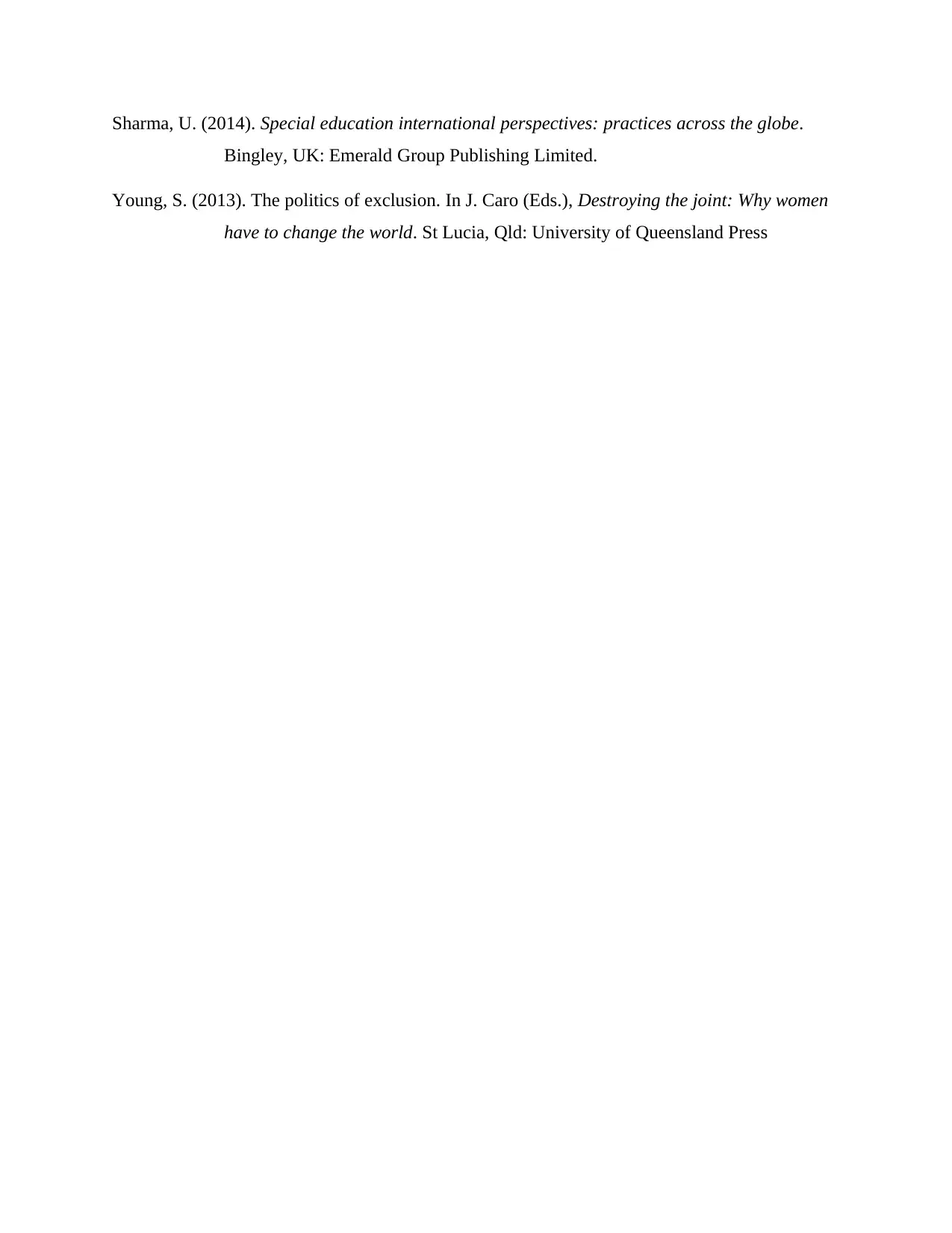
Sharma, U. (2014). Special education international perspectives: practices across the globe.
Bingley, UK: Emerald Group Publishing Limited.
Young, S. (2013). The politics of exclusion. In J. Caro (Eds.), Destroying the joint: Why women
have to change the world. St Lucia, Qld: University of Queensland Press
Bingley, UK: Emerald Group Publishing Limited.
Young, S. (2013). The politics of exclusion. In J. Caro (Eds.), Destroying the joint: Why women
have to change the world. St Lucia, Qld: University of Queensland Press
1 out of 9
Related Documents
Your All-in-One AI-Powered Toolkit for Academic Success.
+13062052269
info@desklib.com
Available 24*7 on WhatsApp / Email
![[object Object]](/_next/static/media/star-bottom.7253800d.svg)
Unlock your academic potential
© 2024 | Zucol Services PVT LTD | All rights reserved.





